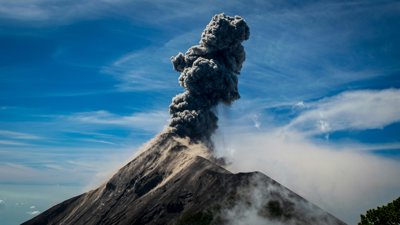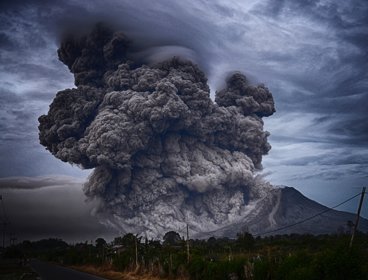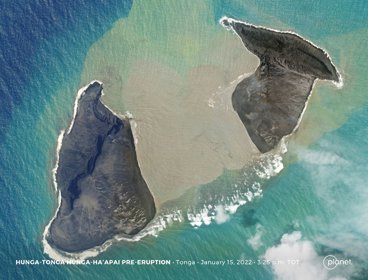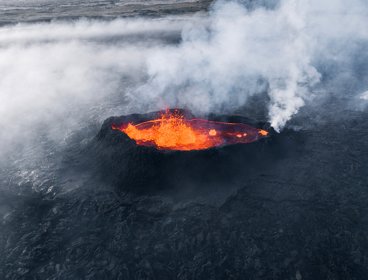You are currently working on the Augustine and Redoubt volcanoes in Alaska, what exactly is it you are doing there and why?
I am a PhD student at the University of Alaska Fairbanks. My research in Alaska is mainly focused on two volcanoes: Augustine, which last erupted in 2006, and Redoubt, which last erupted in 2009.
There are two main parts to my research. Firstly, I study the rocks erupted from these volcanoes. Rocks are made up of many tiny crystals, called minerals. We use X-ray machines to find out what these minerals are made of. This information tells us about the conditions underneath the volcano for the example the temperature and depth of the magma chamber. The second part of my research is to build mini magma chambers in the laboratory. These are essentially high-pressure furnaces. We use these to try and recreate the rocks that were erupted from the volcano. Again, this helps us to understand the temperatures and pressures (depths) at which rocks formed below the volcano.
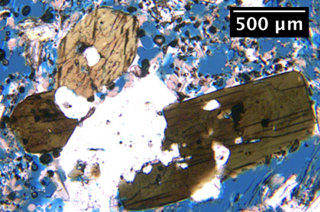
Amphibole crystals found in magma from the 2006 eruption of Augustine volcano. Amphibole is an important mineral that can tell us the temperature and pressure (or depth) at which magma was stored in the crust. The scale bar is in microns (1000 microns = 1mm).
A big part of my job is to work with Alaska Volcano Observatory. When an eruption happens in Alaska, I am part of a team of scientists that respond to the crisis. We travel to the volcanoes to collect samples and see what is going on. The Alaska Volcano Observatory helps local authorities to keep people and property safe. One of our biggest jobs is to tell aviation authorities when eruptions happen. This is so that airplanes can safely avoid ash clouds, which can rise to 30 or 40,000 feet.
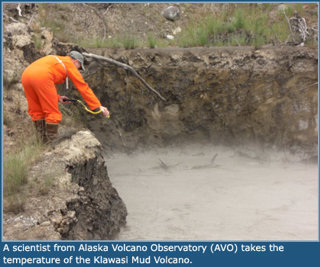
Working on the volcano
I love being a volcanologist because I can make a living exploring some of the most amazing spots on the planet. In addition to Alaska, I have worked on volcanoes in Hawaii, Iceland, the Caribbean, and Kamchatka (Russian Far East).
What will the research you are undertaking be used for?
My research is used to help us understand the inner workings of volcanic systems. The more we know about volcanoes, the more effective we are protecting people and property from their effects. One of the biggest questions to answer is why some volcanoes erupt with big, violent explosions, and why some have gentle eruptions that produce lava flows. My work helps us to understand what controls the type of eruption.
The results of my research get published in journals that are read by other scientists. These journals let scientists and volcanologists around the world share their findings. My work is also used by scientists at the Alaska Volcano Observatory to help prepare for future eruptions at Augustine and Redoubt volcano. 
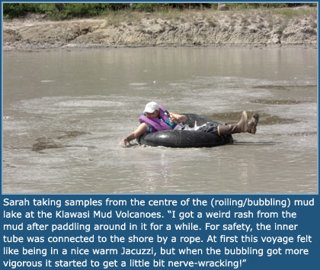
Sampling on the volcano
What type of volcanoes are the ones you are working on?
Volcanoes can be classified in different ways. In terms of their structure, Augustine and Redoubt are both known as stratovolcanoes. This means that they are steep sided volcanoes, made up of layers of deposits from previous eruptions.
Volcanoes can also be classified based on the types of magma that they erupt. Different magmas can have different compositions and this controls the type of eruptions that they produce: big and explosive or gentle lava flow. Both Augustine and Redoubt erupt magmas that we call andesites. Andesites tend to erupt explosively. This is because they are very thick and sticky, a bit like peanut butter. They trap gas bubbles inside and over time lots of pressure can build up. Eventually the pressure is too large and they produce explosive eruption that can throw ash and rocks thousands of meters into the air. Andesite volcanoes are very common at subduction zones.
What type of plate boundary are the Alaskan volcanoes on?
The Aleutian Arc of Alaska is a subduction zone boundary.
The Earth’s crust is made up of huge tectonic plates. Some plates are made of dense, heavy rocks. These plates usually underlie oceans. Other plates are made of lighter rocks. These lighter plates usually support the continents. When denser plates crash head on with lighter plates they sink below them. This is called subduction. In Alaska, the Pacific Plate is subducting below the North American plate at velocity (speed) of about 55mm/year. This is a similar to how fast your nails grow.
There is a supervolcano in Yellowstone – does this mean there could be supervolcanoes elsewhere in the USA?
A supervolcano is one that has had an eruption in which 1000km3 of material was erupted. You can think of that as a cube, where each side is 10km long. Yellowstone is the most famous supervolcano. This is probably because it remains a fairly active volcanic area (the whole region lifts up and down as if it were a balloon that you let air in and out of. There are also lots of earthquakes, and lots of hot features such a geysers). However, the Long Valley Caldera in California is also classed as a super volcano. The most recent supervolcanic eruption on earth was at Toba Volcano, Indonesia, 74,000 years ago.
Are the Augustine and Redoubt volcanoes classed as active volcanoes? Does Alaska have many volcanic eruptions?
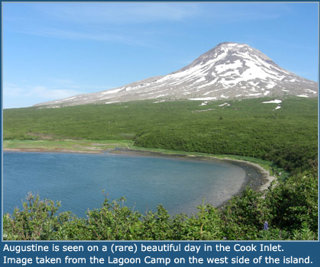
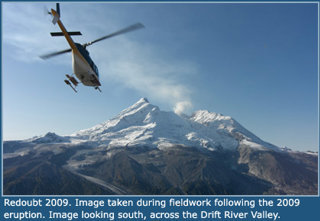
Augustine and Redoubt Volcanoes are both active. Augustine has erupted seven times in the last 200 years, most recently in 1986 and in 2006. Redoubt erupted most recently in 1989/90 and again in 2009. Eruptions at these volcanoes are not just single explosions. Eruptions actually involve many months of activity that can range from huge explosion that produce ash clouds that rise to over 30,000 feet, to slow extrusion of lava domes (like toothpaste being squeezed out of a tube). It was the 1986 eruption of Augustine, and the 1989/90 eruption at Redoubt that let to the formation of the Alaska Volcano Observatory.
Overall, Alaska has 52 volcanoes that have been historically active (the last 300 years or so). On average, there is about one eruption per year in Alaska.
Hazards are classed as ‘hazards’ because of the risk they pose to human populations – Alaska is a large country, if a volcano erupts there is it as hazardous as if say Mount Etna erupts?
The hazards associated with an eruption depend on a number of factors, including volcano location, distance to large population centres, proximity of busy aviation flight paths, and of course, the type of eruption. In Alaska, only a small number of volcanoes are close to big population centres. If one of these volcanoes erupts then ash can fall on local populations. This ash can causes health problems when people breathe it in. Also, if it gets wet ash can turn into cement. In some cases the weight of wet ash has caused buildings to collapse. There is also evidence that some past Alaskan eruptions have caused Tsunamis. For people living in coastal areas these can be very dangerous. However, in general the biggest hazard from Alaskan volcanoes is the production of ash clouds. These can rise high in the atmosphere. If jet planes fly through these clouds, they can lose power to their engines. The skies above Alaska are some of the busiest in the world. In 1989 a KLM jet flew through an ash cloud from Redoubt Volcano. Luckily, the pilot was able restart the engines and to land the plane safely, despite millions of dollars of damage.
Mount Etna is on the island of Sicily. This has a much higher population density than most of the areas around Alaskan volcanoes. The hazards associated with eruptions at Etna are really a function of the type of activity. Sometimes Etna erupts gently, producing lava flows. While these can destroy property and infrastructure, they rarely hurt people because they move relatively slowly. In most cases you can outrun a lava flow. However, the economic damage to properties can be large. Sometimes Etna erupts explosively. When this happens there is a threat to aviation, just like in Alaska. These are also problems associated with falling ash, just like in Alaska.
How does our ability to manage volcanic hazards effectively compare to that of other natural hazards like, for example, earthquakes?
In general, volcanoes kill fewer people than other natural hazards, such as tsunamis, earthquakes, or hurricanes. There are several reasons for this. Firstly, volcanoes rarely erupt without giving prior warning. This means that we have time to warn people about the hazards. Secondly, volcanoes do not move. They always stay in the same place. This makes it easier to plan safe or unsafe places to live and work around them. Thirdly, most volcanic hazards are confined to a relatively small area around the volcano. People farther afield might be inconvenienced, but usually they are not killed.
Does the effectiveness of management strategies for volcanic hazards vary from one country to another?
Yes. The effectiveness of management strategies depends on many factors. These include the level of public awareness and education. In countries where volcanic eruptions are common, and where education programmes are encouraged, hazard management is more effective, for example in Japan. Socio-economic factors also play a role. In some less developed countries, local people who live on the flanks of volcanoes are unwilling to leave their homes and businesses because they cannot afford it. Cultural background also plays a role in how easy it is to implement management strategies for volcanic hazards. Hazard managers have to build good relationships with local populations before eruptions occur. This does not always happen.
How do you tell if a volcano is likely to explode? What do volcanologists look for?
We monitor volcanoes using a number of techniques:
-
Seismology: We measure earthquakes that occur below volcanoes. Before and during volcanic eruption earthquake numbers generally increase. Earthquakes also start happening very shallow in the crust, as magma rises to the surface
-
Geodesy: We measure how volcanoes deform by monitoring the movement of GPS stations on the volcano flanks. When magmas build up under volcanoes the volcano inflates, like a balloon. The GPS records this inflation
-
Remote sensing: Satellites take images of volcanoes from space. These satellites are able to identify hot spots on the ground. If a volcano starts to heat up, it may indicate that new magma is about to erupt
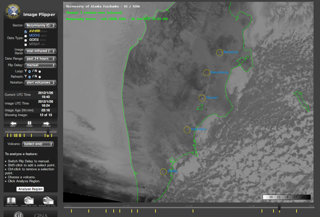
A hotspot at Kizimen Volcano in Kamchatka (Russian Far East).
The remote sensing image is courtesy of the Geophysical Institute and the Alaska Volcano Observatory. This screen capture shows a hotspot at Kizimen Volcano in Kamchatka (Russian Far East). Each of the main volcanoes is denoted by the yellow circles. The bright white spot inside the Kizimen circle is the thermal anomaly (hot spot).
-
Gas: We measure the gases being released from volcanoes. Magmas release gases such as SO2 (sulphur dioxide), CO2 (carbon dioxide), and H2O (water). When new magma arrives below a volcano, the amount of gas released at the summit increases
-
Geology: We can look at the deposits of past eruptions. These can tell us when a volcano last erupted. They also tell us the time intervals between past eruptions
If you had to choose a favourite volcano in the world, which one would it be and why?
My favourite volcano on Earth is the Soufrière Hills Volcano, Montserrat. This is a stunningly beautiful, textbook volcano in the Caribbean. It is also the first volcano that I worked on. I return to visit Soufrière Hills whenever I can.
Other favourites include the Klawasi Mud Volcanoes of Alaska (because mud is fun), Eyjafjallajokul in Iceland (because it raised awareness of the importance of volcano monitoring when it shut down European airspace), and Olympus Mon on Mars (the largest volcano in the solar system, this mountain is 22km high).
I want to become a volcanologist. What do I need to do to become one?
To be a volcanologist you need to work hard in maths and sciences classes at school. You should apply to science programmes at universities. Different volcanologists have different specialities, but in general you will need to study physics, chemistry, math, earth science, and geology. Once you finish your undergraduate degree, you will likely have to go on to graduate school, where you will conduct your own research. Almost all volcanologists have a PhD.
You can also get hands on experience by volunteering to work at volcano observatories or in volcanic national parks (Volcano National Park in Hawaii is a good example of this)
Are there any other jobs I could do besides becoming a volcanologist if I want to work with volcanoes?
Lots of different professions work with volcanoes. For example, when scientists go to do fieldwork they are usually accompanied by field assistants, technicians and pilots (lots of volcanoes are very remote and require helicopter access). Photographers, documentary makers, and science journalists often do work on volcanoes. You could also train to be a tourist guide or a park ranger in a volcanic region.
Sarah was interviewed in February 2012.
Sarah Henton's biography
Sarah Henton is a volcanology graduate student with the Alaska Volcano Observatory and the University of Alaska Fairbanks. She has worked on active volcanoes around the world including Hawaii, the Caribbean, The Russian Far East, and the Aleutian Islands of Alaska. Her current research involves understanding the magma storage conditions and ascent rates at Augustine and Redoubt volcanoes in Alaska's Cook Inlet. In addition to her background as a geologist, Sarah also has a degree in Politics and Geography and is a Fellow of the Society.
